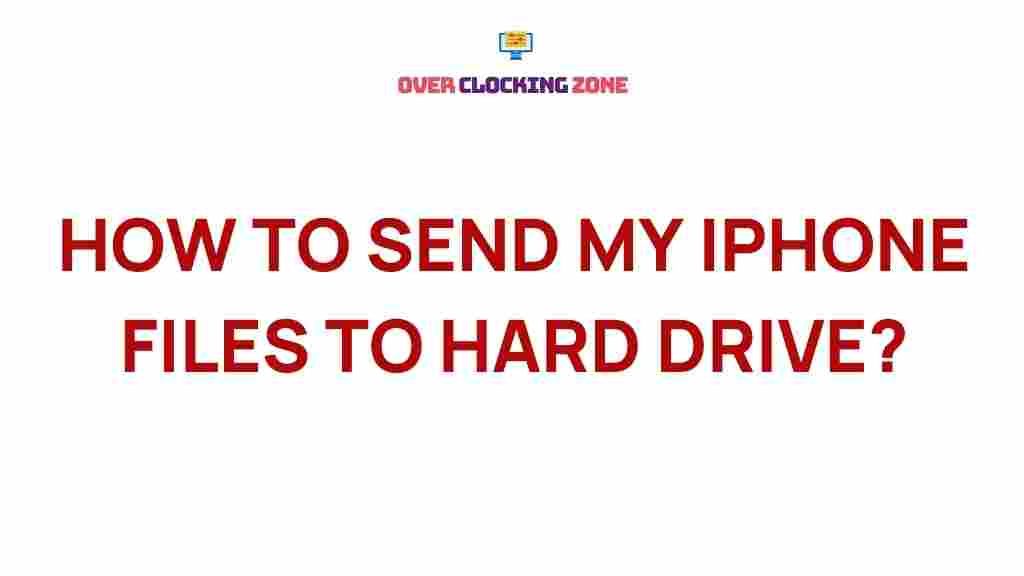iPhone: The Ultimate Guide to Effortlessly Transferring Files to Your Hard Drive
Transferring files from your iPhone to a hard drive is one of the best ways to ensure that your photos, videos, and documents are backed up securely. While iPhones provide a smooth user experience, moving large amounts of data can seem like a daunting task. Whether you’re looking to free up space on your device or create a secure backup, understanding the process can make this task effortless. In this article, we will delve into the best methods for transferring iPhone files to your hard drive, offering solutions for both Windows and macOS users. By the end, you’ll have the tools and knowledge to perform this task with ease.
Why Transfer Files from iPhone to Hard Drive?
There are many reasons why transferring files from your iPhone to a hard drive is beneficial:
- Free up space on your iPhone: iPhones often run out of storage, especially with high-resolution photos and videos. Moving files to a hard drive will ensure your device stays clutter-free.
- Secure backup: Hard drives provide an extra layer of protection for your important files, reducing the risk of data loss.
- Organize your data: You can easily categorize your files into folders, making it easier to locate and access them later.
Step-by-Step Guide to Transferring Files from iPhone to Your Hard Drive
Follow these steps to transfer your files seamlessly:
Method 1: Using a USB Cable (for Windows)
For Windows users, the simplest way to transfer files is by connecting your iPhone directly to your computer using a USB cable.
- Connect your iPhone to the computer: Use a USB cable to connect your iPhone to the PC. Make sure your iPhone is unlocked.
- Trust this computer: A prompt will appear on your iPhone asking whether to trust the connected computer. Tap Trust to allow the connection.
- Open File Explorer: On your PC, open the File Explorer and locate your iPhone under This PC.
- Access iPhone folders: Click on the iPhone icon to open it, and navigate to the Internal Storage section. From there, go to the DCIM folder to view your photos and videos.
- Copy files to the hard drive: Select the files you want to transfer, right-click, and choose Copy. Then, paste them into a folder on your hard drive.
Method 2: Using iTunes (for Windows and macOS)
If you prefer managing files with iTunes, follow these steps:
- Download and install iTunes: If you don’t have iTunes installed, download it from Apple’s official website.
- Connect your iPhone to your computer: Use the USB cable to connect your iPhone. Launch iTunes.
- Backup your iPhone: In iTunes, select your device and choose Back Up Now under the Summary tab. This will create a full backup of your iPhone’s data.
- Transfer files manually: For certain types of files (such as music and videos), you can go to the File Sharing section in iTunes and select the apps you wish to transfer files from. Then, drag and drop files into your desired folder on the hard drive.
Method 3: Using iCloud (for macOS and Windows)
If you prefer a wireless solution, iCloud can be a great option. With iCloud, you can easily access and transfer your files from any device.
- Enable iCloud on your iPhone: Go to Settings > [your name] > iCloud and enable iCloud for the apps you want to back up (e.g., Photos, Notes, Files).
- Access iCloud on your computer: On your Mac, open the iCloud Drive folder or use the iCloud website. On Windows, download the iCloud app from the Apple website.
- Download files: Once logged in, find the files you want to transfer and download them to your computer.
- Move files to the hard drive: After downloading, you can easily drag and drop the files into your external hard drive’s folder.
Method 4: Using Third-Party Apps
Third-party apps like Dr.Fone, iMazing, and AnyTrans offer additional flexibility in transferring files. These apps allow you to manage data across devices and move large amounts of files quickly.
- Download and install a third-party app: Choose an app that suits your needs and install it on your computer.
- Connect your iPhone: Launch the app and connect your iPhone using a USB cable.
- Select files: Browse through the files available on your iPhone and select the ones you wish to transfer.
- Transfer to hard drive: Choose the destination folder on your hard drive and begin the transfer.
Troubleshooting Tips: Common Issues and Fixes
Even with the best methods, some common issues might arise. Here are a few tips to help you resolve them:
- iPhone not recognized by the computer: Ensure that your USB cable is working and that your iPhone is unlocked. If the issue persists, try restarting both your iPhone and computer.
- Unable to access iPhone files: Check that you’ve allowed permission to access your iPhone by selecting Trust when prompted.
- Slow transfer speed: If your transfer is slow, try using a different USB port or a higher-quality cable. Alternatively, consider using a faster transfer method like iCloud or third-party apps.
Conclusion
Transferring files from your iPhone to your hard drive is a simple yet effective way to secure your important data. Whether you use a USB cable, iTunes, iCloud, or third-party apps, the process is straightforward with the right approach. With the methods outlined above, you can easily back up your files, free up space on your device, and organize your data efficiently. If you encounter any issues, troubleshooting tips are available to help you get back on track. Now that you know how to transfer iPhone files effortlessly, go ahead and safeguard your memories and documents today!
This article is in the category Guides & Tutorials and created by OverClocking Team

1 thought on “Unlock the Secret to Effortlessly Transferring iPhone Files to Your Hard Drive”